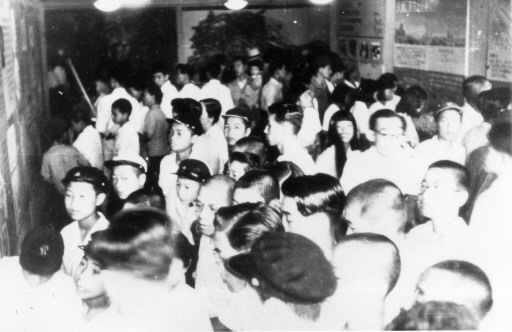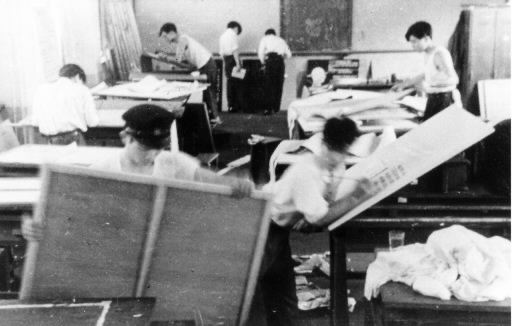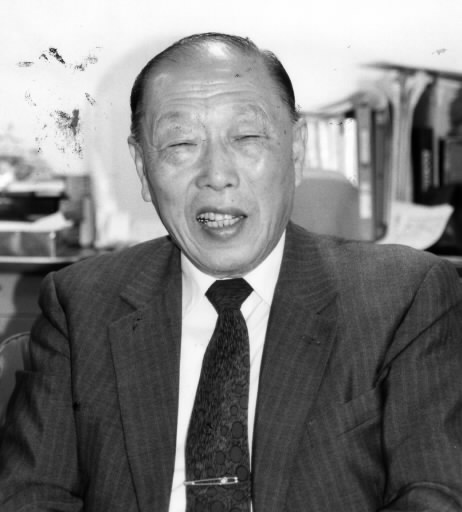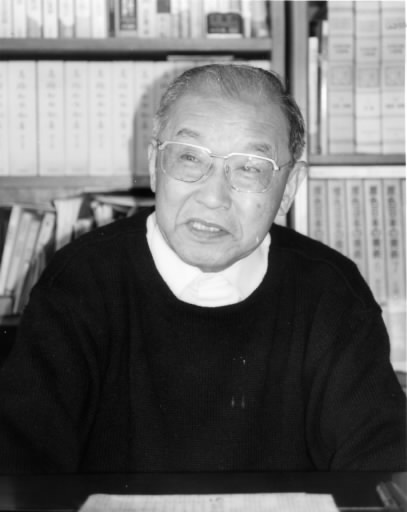History of Hiroshima: 1945-1995 (Part 15, Article 1)
Aug. 1, 2012
A-bomb Exhibitions
by Tetsuya Okahata, Staff Writer
Note: This article was originally published in 1995.
Five years before Olof Palme, the former Swedish prime minister, was assassinated in 1986, he paid a visit to the city of Hiroshima and saw the “Human Shadow Etched in Stone,” one of the exhibits on the atomic bombing found in Hiroshima Peace Memorial Museum. Sharing his impression, Mr. Palme said that if a nuclear war were to take place, there would be nothing left but human shadows--then changed his mind and declared that even our shadows would vanish from the earth.
Even 50 years after the bombing, A-bomb artifacts, conveyors of the horror of that day, possess the power to deeply shake those who gaze upon them. A lunch box charred black. A singed and tattered school uniform. About 1.4 million people visit Hiroshima Peace Memorial Museum each year and listen to the silent cries of these artifacts, searing the horror of nuclear war into their minds and moving them to share the grief of the atomic bombing with the citizens of Hiroshima and other visitors.
The people of Hiroshima have long been gathering and displaying A-bomb artifacts, as far back as the aftermath of the bombing. In order for humankind to survive, they see it as their duty, as those who experienced the horror of the world’s first nuclear attack, to leave behind channels to convey the reality of this catastrophe. However, as the scuffle over an exhibition on the atomic bombing at the Smithsonian Institute makes clear, a large number of people still contend that displays of this kind exaggerate the damage wrought by the bomb.
With personal memories of the A-bomb experience fading, the A-bomb artifacts have assumed an even weightier significance. The Chugoku Shimbun explores the emotions tied to such artifacts of the blast, centering on the stories of Kyoto University students who held the first full-scale A-bomb exhibition, despite the ongoing U.S. occupation, and a woman who donated her hair--hair which fell out due to the aftereffects of the bombing--to Hiroshima Peace Memorial Museum, now marking the 40-year anniversary of its opening.
Under U.S. occupation, Kyoto University students hold first comprehensive A-bomb exhibition
A sepia-toned photograph that captures a surging crowd conveys a quiet fervor. Rediscovered in 1995 after the passage of 44 years, the photo shows a rare glimpse of the “comprehensive A-bomb exhibition” held by Kyoto University in the summer of 1951. One boy is seen with his eyes glued to a panel, probably the first time he has encountered the horrific consequences of the atomic bombings.
This was a time when the people of Japan, still under U.S. occupation following the war, hesitated to even speak about the damage wrought by the bombings. The A-bomb exhibition in Kyoto, mounted by students despite the climate of suppression, was the first such exhibition in the world to fully condemn the “evil of the atomic bomb,” describing the science behind the bomb and the effects of radiation on the human body. What drove these young men and women to organize the exhibition? The Chugoku Shimbun visited the ancient Japanese capital of Kyoto, covered by a springtime haze, and traced the youth depicted in the old sepia-toned photo.
The Kintetsu Department Store stands in front of the main train station in Kyoto. The A-bomb exhibition took place in this building, when the department store was known as the Marubutsu Department Store. Over ten days, beginning on July 14, 1951, more than 30,000 people visited the exhibition. “During those ten days, the students, the customers, and the employees of the store, too, were very fired up,” said Hatsuo Ono, 73, squinting as if longing to restore those days. Mr. Ono, now a resident of Minami Ward, Kyoto, worked in the store’s publicity department back then.
“Now that I think of it, it’s kind of amazing that the exhibition could even be held,” Mr. Ono said. “At the time, Japan was still suffering from the fresh scars of the war. We all felt a sense of mission.” Today, though, the store holds no reminders of that time: the fifth floor, where the exhibition was held, is now a showroom for furniture. However, Mr. Ono can still clearly recall the students who spoke out about the horror of the atomic bombing in hoarse voices, the visitors watching raptly and listening with their full attention.
The world was in turmoil in 1951. The Korean War, which broke out in the year before the A-bomb exhibition took place, was escalating and, within Japan, the “Red Purge” of suspected communists was raging. The National Police Reserve, the forerunner of Japan’s Self-Defense Forces, was also established. The prospect of war was looming again.
“When the war ended, I was glad to finally turn on the lights,” said Ichiro Kawai, 64, then a sophomore at Kyoto University’s Faculty of Medicine and now a resident of Kita Ward, Kyoto. During the war, he had experienced an air raid in his hometown of Okayama. [House lights had to be extinguished when darkness fell due to the threat of air raids.] “But I began to grow concerned, wondering if we would have to start keeping the lights off again.”
At the time, with the students feeling a sense of crisis, there was restiveness at Kyoto University over the punishment meted out for an incident that began with police breaking up a gathering with the drama group “Zenshin Troupe.” In response, the students organized a series of protest rallies. During a march in December that led to Yasaka Shrine, Mr. Kawai and his fellow protesters heard some staggering news: U.S. President Harry Truman had reportedly indicated that he would consider using an atomic bomb in the Korean War.
The Press Code, employed by the occupying forces to control the flow of information in Japan, had by now been significantly relaxed, and publications on the atomic bombing were being made available to the public. Still, for most citizens, the reality of the bombing remained largely obscured.
At the Faculty of Medicine at Kyoto University, Shigeyasu Amano, an associate professor at the time, offered a unique and well-attended course entitled “Course on A-bomb Diseases.” This talk drew on the research conducted on the bodies of A-bomb victims that an investigative team from Kyoto University had brought back to Kyoto from Hiroshima in the aftermath of the atomic bombing. Even when confronted at gunpoint by an American military officer, Professor Amano continued to keep these specimens concealed. The lectures given by the professor raised awareness of the atomic bombing among the students of Kyoto University, and for this reason they had a sensitive reaction to Truman’s statement about potentially using an atomic bomb.
The sense of urgency felt by the students led to an A-bomb exhibition at a cultural festival in May, prior to the A-bomb exhibition held at the Marubutsu Department Store. Featured at this festival were lectures delivered by Professor Amano, Professor Kiichi Kimura of the Faculty of Science, who had been a member of the investigative team which visited Hiroshima, and Yoko Ota, an author on the atomic bombing.
In fact, Professor Amano and Professor Kimura had both been reluctant to speak at the festival. At the time, peace gatherings across Japan were facing suppression from authorities. One student, though, came up with the ploy of approaching both professors simultaneously and telling them that the other professor had already agreed to speak. But the ruse was quickly undone and Professor Amano scolded the remorseful students, calling them “malignant.” Nevertheless, both professors took the podium at the festival.
It was not until much later that the students learned Professor Amano had nearly been arrested by the General Headquarters of the Allied Powers (GHQ) over the possibility of his giving a speech.
The cultural festival stirred a strong response. There was now a growing desire among the students to hold an A-bomb exhibition for the public. Hiroshi Aoki, 67, now a resident of Tokorozawa City in Saitama Prefecture, was then the leader of the Dogakukai, the student council at the university. He recalled: “The A-bomb exhibition wasn’t a plan drafted by the Dogakukai. It came together organically at the university as a comprehensive A-bomb exhibition geared for ordinary citizens.”
Mr. Ono, the department store employee, said that he was shocked when he saw some artwork that was brought to the publicity department. It was a copy of “Hiroshima Panels,” painted by the married duo Iri Maruki and Toshi Maruki, and it served as the backbone of the A-bomb exhibition. After graduating from the Third High School, Mr. Ono entered the University of Tokyo. But when students were mobilized for the war effort, he was deployed at the Army Aviation Signal School in Mito, Ibaraki Prefecture. The painting brought back the daily air raids he endured and the cruel image of a friend who died alongside him.
“In my mind, we had to hold the exhibition, by all means,” Mr. Ono said. “At the time, all the museums in the city were under the thumb of U.S. forces. I felt it was our mission, on their behalf, to assume this role at the department store.” In fact, the Marubutsu Department Store was the third company that the students approached with the idea of holding an A-bomb exhibition. After securing that venue, and overcoming their primary obstacle, the students threw themselves into organizing the event. They planned to open the exhibition in less than three months.
Hiroyuki Miyagawa, 65, now a resident of Nishi Ward, Hiroshima, was a sophomore at the university back then, a student in the Faculty of Letters. He said a classmate approached him on the campus and told him, “You’re an A-bomb survivor so you should help with the A-bomb exhibition.” It was a curt request, but Mr. Miyagawa agreed to join the effort in a curt reply: “Okay.”
Mr. Miyagawa had experienced the atomic bombing while in the Minamimachi district. He was part of a group of writers at Kyoto University, along with Kazumi Takahashi and Sakyo Komatsu.
In conjunction with the A-bomb exhibition, they decided to issue a collection of writing about the A-bomb experience. Mr. Miyagawa, among others, walked the back alleys of Kyoto, hoping to locate A-bomb survivors. One former soldier, whose arms were covered with keloid scars, spoke from his bed and described that day in a halting voice. One woman who lived in a row house told him, before slamming her door shut, that she hated recalling that time. Mr. Miyagawa also asked a friend in Hiroshima to collect some writing, and, in all, 13 written accounts were obtained.
But as the students were moving forward, at full speed, with their plans for the exhibition, they ran up against an unexpected wall. Marubutsu Department Store, apparently bowing to pressure from the police, withdrew their support and indicated that the building could no longer be used as the venue. Mr. Ono and other backers of the project responded by asking, “Why now, at this late date?” The company, however, stood firm. It was thanks to the intervention of Masashi Kadonami, 79, who was then the head of the student affairs office and now resides in Sakyo Ward, Kyoto, that a breakthrough occurred. The previous year, Mr. Kadonami had, in fact, stirred the students’ ire, and been branded a tool of the authorities, when he issued an order which forbid the students from engaging in strikes.
“We were painfully aware of the misery of war,” Mr. Kadonami explained. “Besides, the atomic bomb now presented a new challenge to humanity. When I saw the students working so hard, with so much spirit, to organize the exhibition, I wanted them to realize the event.” Staff members of the student affairs office then negotiated with a Marubutsu executive, a graduate of Kyoto University, and were able to obtain the company’s consent once more. At the same time, they had to agree to certain conditions, including that the exhibition be “apolitical” and that no signatures be gathered.
In mid-summer, the bells of the Gion Music Festival rang out on the streets of Kyoto. Despite the sweltering heat, preparations for the A-bomb exhibition moved into their final phase. Each department of the university created a set of information panels, in line with its specialty. Students of the Faculty of Medicine created panels explaining the effects of radiation on the human body, while students of the Faculty of Engineering created panels describing the destruction wrought by the bombs. The total number of panels climbed to 190. Along with the students from Kyoto University, students from the Kyoto Institute of Technology and the Kyoto City University of Arts joined in the effort to produce these panels, eating on the fly and sometimes working through the night without rest.
When the curtain finally came up on the first full-scale A-bomb exhibition, the venue was a scene of exhilaration. Some students even delivered inflammatory speeches and collected signatures, activities that had been prohibited by the department store. Still, the Marubutsu side made a wry smile and said, “They did it, after all.” Among the visitors were a U.S. solider and a member of Japan’s National Police Reserve. Also drawing attention was an elderly woman who placed her hands together in prayer in the direction of a student explaining the difficult theory behind the making of an atomic bomb.
The panels used at the exhibition were later loaned out to other universities and local communities, helping to spread “small A-bomb exhibitions” across the nation. However, the police, which did not openly interfere in Kyoto, became a more conspicuous presence in the rural areas that sought to hold exhibitions.
Tetsuo Obata, 67, now a resident of Yawata City in Kyoto Prefecture, was a freshman in the Faculty of Letters when he put up panels for display on the walls of an elementary school in Otsu City, Shiga Prefecture. Afterward, he was stopped by the police and brusquely handcuffed on suspicion of violating the Road Traffic Act. After graduating from the university, Mr. Obata, who became a high school teacher, shared his experience with his students. “The students laughed,” he recalled, “joking that I had been a member of a motorcycle gang. Considering my experience, it’s a wonder the large A-bomb exhibition in Kyoto encountered no interference from the police.”
The smaller A-bomb exhibitions elicited a strong response in many locations and planted the seeds of new peace campaigns among schools and youth groups, eventually culminating in the nationwide peace movement which rose in the wake of the nuclear disaster involving radioactive fallout from a U.S. hydrogen bomb test at the Bikini Atoll in 1954. At the same time, the Dogakukai, Kyoto University’s student council, was ordered to disband in November of 1951, months after the A-bomb exhibition was held, following an incident in which the organization issued an open letter to Emperor Showa. The A-bomb exhibition itself was then buried by history.
Looking back on that era, Mr. Aoki said: “After Japan’s defeat in World War II, the time of the U.S. occupation was the youthful period of Japan, now freed from war.” There are still many questions as to why the A-bomb exhibition spearheaded by Kyoto University students was able to succeed under the occupation. But there is no doubt that the feelings shared by the Japanese people, in wishing to know and convey the facts of the atomic bombings, served as the inspiration for the students to act.
Three years ago, Mr. Kawai and others began an effort to dig up distant memories of the A-bomb exhibition to record the summer of 1951 for posterity and reflect on their experience of the post-war period. This is the message from the young people in the sepia-toned photo, which still echoes to the youth of today: “We must not wage war again.”
(Originally published on April 30, 1995)











